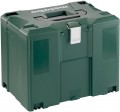The main size of the container for tools. Inches are traditionally used for this designation, and the length is usually indicated as the main size. This information allows you to evaluate the "weight category" of the product as a whole, as well as to determine whether it is suitable for a particular instrument of large sizes. At the same time, the characteristics usually indicate the overall dimensions on all three main sides (in millimetres), however, it is more convenient for many craftsmen to use the size designation in inches.
For kits (see below), this paragraph indicates the dimensions of all containers supplied in the kit.
The material from which the container locks are made. Most often we are talking about fasteners that close a case or drawer, but sometimes this information is indicated for fasteners in bags, backpacks, etc. The main materials for their manufacture are:
-
Plastic. Plastic is inexpensive, but in general it is inferior to metal in terms of strength and reliability. However, often these moments do not play a decisive role (or are compensated by design features - for example, the large thickness of individual parts).
-
Metal. Metal locks are very durable and reliable, but they are more expensive than plastic ones. Tool boxes and containers made of almost any material can be equipped with such locks.
—
Plastic with metal. This combination is not uncommon in the design of tool boxes and containers. As a rule, the locking bracket of the lock is made of metal, which bears the main load in the locking mechanism, and the “tongue” is made of plastic.

